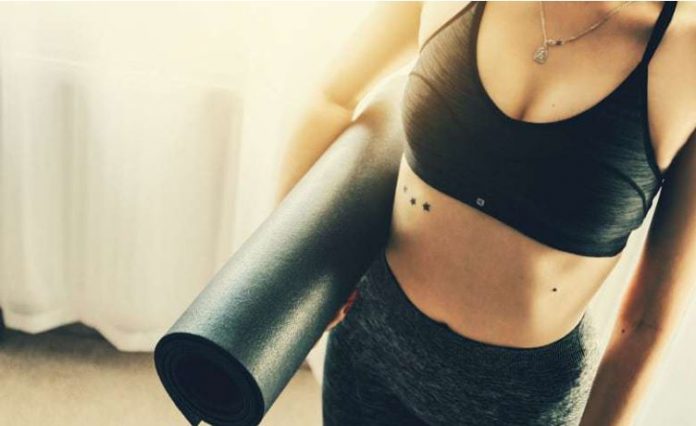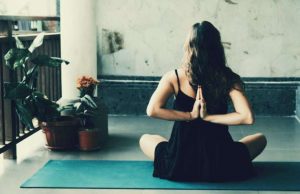Yoga has been practiced for thousands of years and is often called India’s gift to the world. Yoga even has a UN resolution proclaiming the 21st of June to be International Yoga Day. The benefits of yoga for the mind are well known, with one study revealing that after a single session, or after only 20 minutes of yoga your brain function improves. Yoga has many benefits for your body too, it can help increase fat loss, tone your muscles and improve overall flexibility of your body. The effects on your body may not be as immediate, but in the long term yoga will help you achieve a more lean-looking physique and have many healthy benefits for the workings of your body.
Reasons for Yoga
When you think of yoga the first thing you may think of is inner peace and calmness. Yoga is a great form of meditation but can also be an excellent form of exercise, working the whole body. Yoga can help lower stress levels by focusing on breathing and a connection of the mind, body and soul allows you to take your mind off the stresses of modern life and achieve ultimate relaxation.
The physical effects of yoga can be just as powerful and transform your body. More than 36 million Americans practice yoga according to the 2016 Yoga in America study with many gyms now offering yoga classes. When working on a multinational military base, even the army PT instructor was running early morning yoga sessions to improve the fitness of the troops.
Surprisingly stress relief was only the second most common reason given for starting yoga in the 2016 survey. More commonly people recognized the physical benefits with 61 percent saying they started to improve their flexibility and in fourth place physical fitness was the response of 44 percent of the participants. Some more intense forms of yoga can give the body a workout that rivals even the most strenuous of cardio sessions. Yoga can help us achieve that buff body we’ve always wanted and improve our health without the need to spend a small fortune on equipment or expensive gym membership.
Flexibility as the Number One Reason to Start Yoga
Let’s start at the top, flexibility was recognized by a 2011 study from International Yoga Journal to be “the first and most obvious benefit of yoga”. Regularly practicing yoga can loosen the muscles and connective tissues surrounding your bones and joints over a period of time. In your first session your shoulders, back and hamstrings will become more flexible. Bikram yoga, a form of yoga performed in a heated room, has been found to increase the flexibility effects on your body.
When you first see a more experienced yogi tying their body in knots like a human pretzel, you may think you’ll never be able to achieve anything like that. If you don’t keep your body conditioned you may never achieve anywhere near this, as joints will settle into a more limited range of movements. You may not even be able to touch your toes in your first yoga class nevermind sticking them round the back of your head, but the more you practice yoga the more you’ll notice your body gradually loosening up. We’re not promising everybody will reach a stage where they can form a human pretzel, but you’ll notice more flexibility in your joints.
Yoga Can Improve Your Posture
Being told to sit up straight or to stop slouching used to be one of my mother’s more common criticisms as I grew up. Not only does bad posture look bad, it can also have many negative effects on your health including back aches, neck pain, joint problems and muscle fatigue. Yoga is one of the best ways to improve your posture as many of the poses aim to rearrange your body in proper alignment without forcing you into unnatural positions (except maybe the more advanced pretzel!).
Yoga poses work on the posture of the whole body, not just the back, requiring all parts of the body to work together from your neck to your shoulders, your back and lower body. It can be useful to take a full length snap of yourself before taking your first yoga class and randomly updating your photos after several more classes. You may not notice your posture improvement immediately, it’s hardly something you look at in the mirror and compliment yourself on. But over time by looking at the photographic evidence you’ll notice a significant change in your posture, probably after everybody else has noticed it.
An Improved Sense of Balance
Closely related to your flexibility and posture is the improvement in balance you’ll experience due to yoga. When first starting yoga even some of the easier poses or stretches can require a great deal of focus and concentration. As you get more experienced you’ll find yourself not having to concentrate as hard, even for the more advanced poses. This is because your balance will have naturally improved. Yoga poses, whether sitting or standing require you to center your body even when it seems the pose doesn’t require too much balance.
Yoga to Strengthen the Body
Even the more gentle forms of yoga like hatha, integral or lynegar yoga can result in an upsurge of strength in your body. Hatha yoga has many poses which strengthen your chest, abs and core. Poses like the forearm plank or boat pose can help you build greater core strength while other moves like the Chaturanga can build upper body strength.
A group of 79 adults who performed 24 cycles of sun salutations, a pose often used to warm up, six days a week for 24 weeks were shown to have experienced a significant increase in upper body strength and endurance in addition to weight loss. There was also a decrease in the percentage of body fat in women.
Unlike many other forms of exercise, you don’t need any weights or resistance bands to perform a yoga pose, you simply enter into and hold a position to naturally strengthen the muscles. In this sense yoga can be classed as a bodyweight exercise using only the weight of your body. For bigger gains you simply hold the pose for longer. As soon as one pose becomes too easy, there are always many more to move onto that can challenge the body in a different or more intense way.
Yoga to Tone the Body
One of the things that can put many people off the idea of resistance training or strength training, especially more petite ladies, is the idea of bulking up or getting stacked. Yoga is a resistance exercise which uses your body weight to provide the resistance rather than weights or other equipment but it won’t make you bulk up rather it will give you a leaner looking figure.
More intense forms of yoga like power yoga, Ashtanga, Vinyasa, Bikram or hot yoga will give you a more dramatic transformation with increased muscle tone (not bulk) and greater fat loss. Longer strings of poses with fewer breaks and more challenging poses that move the body more can give you all the benefits of the gentler types of yoga but with the health benefits of a cardio workout. Bikram or hot yoga will also make you sweat more with a room that’s kept at a much higher temperature for maximum effect.
If your eventual aim is to build bigger muscles then weightlifting will give you better results, but yoga can give you the focus of mind and more flexibility to complement traditional weightlifting or resistance-based workouts. The more gentle and meditative aspects of yoga can also help get rid of delayed onset muscles soreness (DOMS) often caused by a tough physical activity like a 10k run or a boot camp workout. Stretching and meditation of hatha yoga or a restorative class can help if you’re experiencing DOMS.
Yoga Gives the Body More Energy
Yoga, like many exercises, can boost the body’s energy levels and help fight fatigue. Better sleep that results from the meditative effects of yoga can lead to a more energized day and some studies have shown that yoga poses can adjust the hormone cortisol. If you have too little of this hormone, your body can feel zapped of energy but you don’t want too much of it either.
Another key to increasing the energy levels in our body is the waves of fresh oxygen your blood receives from being taught to breathe deeper by yoga practice. Yoga poses like utthita trikonasana, utkatasana and salabhasana can help beat fatigue and leave you feeling more awake and ready to face the day.
Health Benefits of Yoga
So far we’ve only really looked at the external physical benefits of yoga as a way of toning the body and increasing our physical fitness. But yoga can have many benefits for the inner health of our bodies. By practicing yoga, long-term effects can include lower blood pressure, an improved lung capacity, reduction in chronic neck and back pain, stronger bones, lower blood glucose levels, a healthier weight and less anxiety.
Yoga Asanas Can Lower Blood Pressure
Yoga can be one of the best ways of reducing your blood pressure and improving heart health. The calming and meditative features of many yoga poses can help reduce stress, one of the leading causes of hypertension. One study that looked at the effects of yoga on patients with high blood pressure over the age of 40 found those who had practiced yoga for five years or more had significantly lower blood pressure and pulse rates than a control group who hadn’t practiced yoga. The study also found yoga reduces the age related deterioration of cardiovascular functions.
The benefits of yoga for patients with heart disease has been studied with lifestyle changes including a year of yoga training in combination with dietary changes and stress management having positive effects on the 113 patients in the study. A reduction in overall cholesterol of 23 percent with a 26 percent reduction of the bad or LDL cholesterol was found with the bonus of heart disease having stopped in 47 percent of the patients.
Yoga and Gene Expression
The last thing you’re probably thinking of when pondering how yoga changes your body is your genes, but it can go some way to explain why yoga is so beneficially to you body’s health especially the immune system. Yoga has an almost instant impact on your genetics from the very first session, strengthening your immune system and is often recommended to many patients by their doctors.
Yoga can be as effective or even more effective than many traditional exercises in causing health benefits through genetic changes. A Norwegian study looked at the blood of 10 subjects who took part in a week-long yoga retreat both before and after four-hour-long yoga sessions. Yoga changed the expression of 111 genes in immune cells found circulating the body compared to just 38 genes in music or walking based relaxation.
Effects of Yoga on Ageing of the Body
As well as improving your body fitness and function, yoga has been shown to boost your youthfulness by increasing telomerase activity in the body. Basically yoga can be much more efficient against ageing than that $100 pot of cream you may have lurking in the bathroom cabinet.
Strands of DNA called telomeres that sit on the end of chromosomes can shorten when cells divide and if they get too short the cell can no longer function and dies. Short telomeres are a symptom of cellular ageing and can lead to many chronic diseases including diabetes, heart disease and dementia. An enzyme in our body produces telomerase that helps the telomeres stay long and remain healthy. Meditation through yoga has been shown to increase the function of this enzyme and reduce cellular ageing.
Yoga for a Healthy Mind and Healthy Body
Although yoga has been around for thousands of years, the scientific research on how yoga changes your body is still relatively new. Yoga has the potential to change your body as well as your mind, with the practice of mind and body togetherness being at the heart of the yoga ideology. Less stress and anxiety with more focus and concentration will have a profound effect on the health of your body and the physical demands of yoga can improve your overall fitness levels and tone the body too.
Incorporating yoga into your fitness routine can be an excellent way of managing stress, improving your fitness and just generally feeling and thinking more positive. Now go get that mat out and get your namaste on!
This article is intended for informational purposes only. If you have any questions or are considering any recommendations, please consult your health practitioner.
























